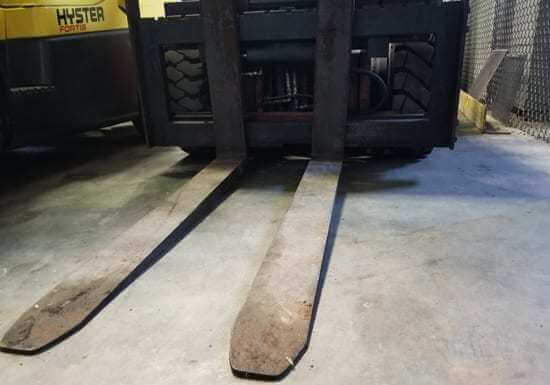The forks of a forklift are essential to its operation. Forklift tines, or forks, are used to lift and carry big items. When their structure is damaged, their safety is at risk.
Perform regular checks to ensure that the equipment is safe for use. If a part fails, the forklift should be pulled out of service until the repair has been performed.
A bent forklift can go undetected by the naked eye, so be aware of this possibility. Since pallet forks can bend in any direction, a bent fork may not be readily apparent from all sides. If your forklift forks have an angle of more than 93 degrees, they are bent.
Keeping your forklift in good working condition is very important, but things can go wrong sometimes. It’s important to keep your forklifts in good working order, yet things can go wrong. Maintaining your equipment isn’t always easy. You’ve come to the right place if your forklift forks are bent and looking for a solution.
How to Repair Bent Forklift Forks
The best answer is that you need to find new forks. Some people heat and bend their pallet forks in videos online. Some folks even use a hydraulic press to fuse their forklift tines.
This may appear to be a quick remedy, but the integrity of the steel is destroyed when it is heated to high temperatures. The integrity of the forks can never be restored once they’ve been tampered with. Forklift tines may look the same as they did in the past, but that doesn’t imply they’re as strong as they used to be. If you heat your forks to “repair” them, you won’t know their new forklift capability. Consequently, you will never be able to work securely.
If you’re tempted to try a DIY remedy, know that doing so is not a long-term solution. Instead, it poses a significant threat to one’s safety. If your forklift blades are bent, spend a few hundred dollars on replacement ones.
How to Avoid Bends in Forklift Fork
Collisions, poor loading, and overloading are the main causes of bent forklift forks. Understanding these problems and avoiding them will save you money on future forklift blade replacements.
Proper forklift maintenance is the first step in equipment care. Servicing your forklift regularly might help prevent minor faults from becoming dangerous. Every day, operators should inspect their forklifts. They should undertake a thorough inspection once a year.
Annual forklift fork inspections should include:
1. Inspect the blade and shank angles. If over 93 degrees, replace forklift forks.
2. Visually inspect the forks for surface cracks, especially at the heel and welds. Ensure the blade and shank are straight.
3. Check that the points of each forklift blade are nearly the same height. If the difference surpasses 3% of the blade’s length, it’s time to replace it.
4. Use calipers to gauge each blade’s thickness. Forklift blades that are 10% worn lose 20% of their load capacity, necessitating replacement.
5. Use calipers to examine fork hook wear. Replace your forks if the hook lip touches the caliper’s back.
It’s important to keep your forklift blades in good condition by operating your machine within its capabilities. Forklift load capacity should always be checked against the manufacturer’s specifications. Keep in mind that the load center’s capacity changes with the load. Consult the capacity chart on your equipment to know about its capacity.










